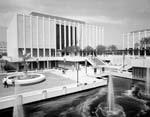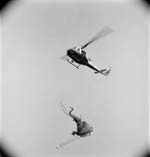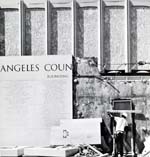
|

|
|
Home Site Search Contact Us Subscribe
|
|
|
The Blob That Could Eat Los Angeles The history of our ill-fated Los Angeles County Museum of Art is told in "The Presence of the Past: Peter Zumthor Reconsiders LACMA": I'm a fan of Zumthor, but this building could be cool almost anywhere else. By Julie D. Taylor, Hon. AIA/LA August 8, 2013 The history of our ill-fated Los Angeles County Museum of Art (LACMA) is told in “The Presence of the Past: Peter Zumthor Reconsiders LACMA” (through September 15, 2013), an exhibition meant to introduce us to the next big thing for the Wilshire Boulevard campus. Angelenos are used to “projects that cried wolf” – huge plans that are seldom realized. Just recently, though, some of them are coming on board, such as increased public transportation, as well as elements of the long-promised Grand Avenue renaissance: Rios Clementi Hale Studios’ Grand Park opened last year to great success, and Diller Scofidio + Renfro’s Broad Museum is materializing quickly.
When it comes to LACMA, however, we’ve been fooled before by extensive plans and schemes. And, frankly, I don’t mind. I like it how it used to be. Granted, this an emotional issue for me. I grew up wandering the galleries, getting my first introduction to the visual arts, with which I would be involved my entire life.
Michael Govan, LACMA CEO and Director, who has brilliantly succeeded in putting the museum on the international map, wants to totally overhaul of the physical space. The original 1965 William L. Pereira and Associates, and the later Hardy Holzman Pfeiffer Associates (HHPA) 1986 additions on the eastern side of the campus would be demolished and replaced with a large edifice by Swiss architect Peter Zumthor. Bruce Goff’s 1988 Japanese Pavilion and Renzo Piano’s 2008 Broad Contemporary Art Museum (BCAM) and 2010 Resnick Pavilion will remain.
The exhibition (part of the Getty’s Pacific Standard Time Presents: Modern Architecture in L.A. initiative) starts with a history of the museum’s built life as a lead-up to this monumental change. Always fascinating are aerial photos of the Wilshire/Fairfax area showing its quick development. Other introductory materials focus on the neighboring La Brea Tar Pits, including magazine articles showing the mammoth sculptures being transported through the streets of L.A. to be placed in the pits (a foreshadowing of Michael Heizer’s giant rock parade?).
With the site context explained, we get to the Pereira buildings. More photos, magazine articles, TIME Magazine cover of the architect, and, most interesting, notes from board meetings. The Board of Directors’ original choice was Ludwig Mies van der Rohe, but they had to check with big donor Howard Ahmanson before selecting. His choices were Edward Durell Stone or Pereira. There is a wealth of information from various sources in this one display case.
What is incomprehensible is that the same amount of physical space is allotted to the HHPA catastrophe. In the same size display case there is much less material, scant thought, and no context; two elevations and three copies of a self-published brochure open to different pages is all. Perhaps it is a tacit admission of guilt and regret of those in charge then (no names, no process, no memos), who ruined the campus, essentially turning its back on the street.
It was good to see some national acknowledgement for Pereira. I know I’m in a silent architectural minority who truly loves the original buildings. In many discussions in the early 2000s about LACMA’s inadequacies, all the blame was put on Pereira; HHPA’s atrocities were rarely mentioned. Even the L.A. Conservancy never came to the rescue! The animosity felt toward them at this moment in time is ironic, as Christopher Hawthorne noted in the LA Times (May 1, 2013). “Pereira’s architecture is featured prominently in ‘Overdrive,’ the anchor exhibition of the Pacific Standard Time Presents series,” he writes. “Whether that new spotlight will mean fresh public or political support for his much-maligned buildings at LACMA, of course, remains to be seen.”
The next “big idea” comes from Rem Koolhaas. In 2001, an international competition short-listed Jean Nouvel, Stephen Holl, Daniel Libeskind, and Thom Mayne, along with Koolhaas. Only the winning model is shown in the exhibition. Govan’s wall-note admits Koolhaas was the only finalist to propose doing away with the entire campus. But he doesn’t mention anything about the requirement to keep the existing buildings as part of the competition brief. That Koolhaas won in spite of breaking the rules was, to me, another outrage, and supremely unfair to the finalists. Given a clean slate, the others could have presented equally intriguing schemes. The only time I ever voted against a building bill was when this was on the ballot. Finally, I was in the majority. Lacking the cash, the scheme was killed.
The museum-architect-of-the-moment in the mid-to-late 2000s – Piano – was selected by Eli Broad for his BCAM. The building went up remarkably quickly. Broad then had Piano envision a new master plan for LACMA’s transition, which included the Resnick Pavilion. Govan enters in 2006 and works a bit with Piano until the politics of ego arise.
Determined to make his own mark, Govan has commissioned a big, black, amorphous one. Among Zumthor’s ideas is that the building be sprawling like L.A., and mirror the oozing goo of the Tar Pits. It’s not the sophisticated concept I had expected from Zumthor, whose 2007 Bruder Klaus Field Chapel makes me swoon. But this building projects darkness, which is not at all L.A., and appears not as a light-filled art museum, but more as a theater or aquarium complex.
A number of proposed gallery sections are elevated to eye level, but it’s the 30-foot-long model that really attracts attention. And it should – it’s a gorgeous, expressive model. Another site model relates the greater context of the relationship to the surrounding streets and other buildings on the campus, which are dwarfed by the new project. As the huge blob meets up with the largest of the Tar Pits, it also diminishes that vast natural phenomenon.
To be fair, what we’re seeing is a first-pass – schematics and concepts. Anyone who knows about the process of architecture knows about change. How much the scant information will appeal to the public is questionable. Plans and sections offer little enlightenment. The energy diagrams by Transsolar (an inspired hire, as one cannot find a more creative climate engineer) are not clear in terms of the promised natural light. Viewed under the Resnick Pavilion’s natural illumination – one of the few elements that works elegantly in the building – the model demonstrates no way to return the favor. As well, it is stated that the very black roof will be covered in solar cells, but it’s not shown how that will affect the blackness of the roof.
But, who knows? Maybe by the time Govan raises the $650 million needed, solar panels will look completely different from how they do today. Frankly, I don’t think this will ever come into existence. Perhaps they should just move the model across the street to the Architecture + Design Museum’s new show, “Never Built: Los Angeles.”
I’m a fan of Zumthor. But I think this building could be cool almost anywhere else. It doesn’t speak to me of LACMA. And it doesn’t have the brightness or optimism of Los Angeles. I remember as a kid, flying into L.A. and gazing from the plane window at the amoeba-shaped pools dotting the backyard landscape. Seeing the amorphous, sparkling turquoise shapes, I knew exactly where I was going. I wish my beloved LACMA knew, too.
Julie D. Taylor, Hon. AIA/LA, is West Coast correspondent for ArchNewsNow.com, editor of Society of Architectural Historians/SCC News, and principal of Taylor & Company public relations and marketing for the design industries.
Also by Taylor:
Overdrive:
L.A.'s Future is Present in its Past
|
(click on pictures to enlarge)  ©2013 Museum Associates/LACMA Peter Zumthor’s proposed new LACMA scheme dwarfs the surrounding context.  ©2013 Museum Associates/LACMA The new LACMA building sprawls through the site.  ©2013 Museum Associates/LACMA One of several section models shown at eye level to simulate the art-viewing experience.  ©2013 Museum Associates/LACMA So many models; so little information.  ©2013 Museum Associates/LACMA, photographic archives William L. Pereira and Associates’ Los Angeles County Museum of Art the year it opened, 1965.  ©2013 Natural History Museum of Los Angeles County, Museum Archives Columbian mammoth by sculptor Howard Ball flying over Hancock Park, 1968.  ©Tim Street-Porter A lethal blow: demolition of LACMA plaza for the construction of the Anderson Building by Hardy Holzman Pfeiffer Associates, 1984. |
© 2013 ArchNewsNow.com